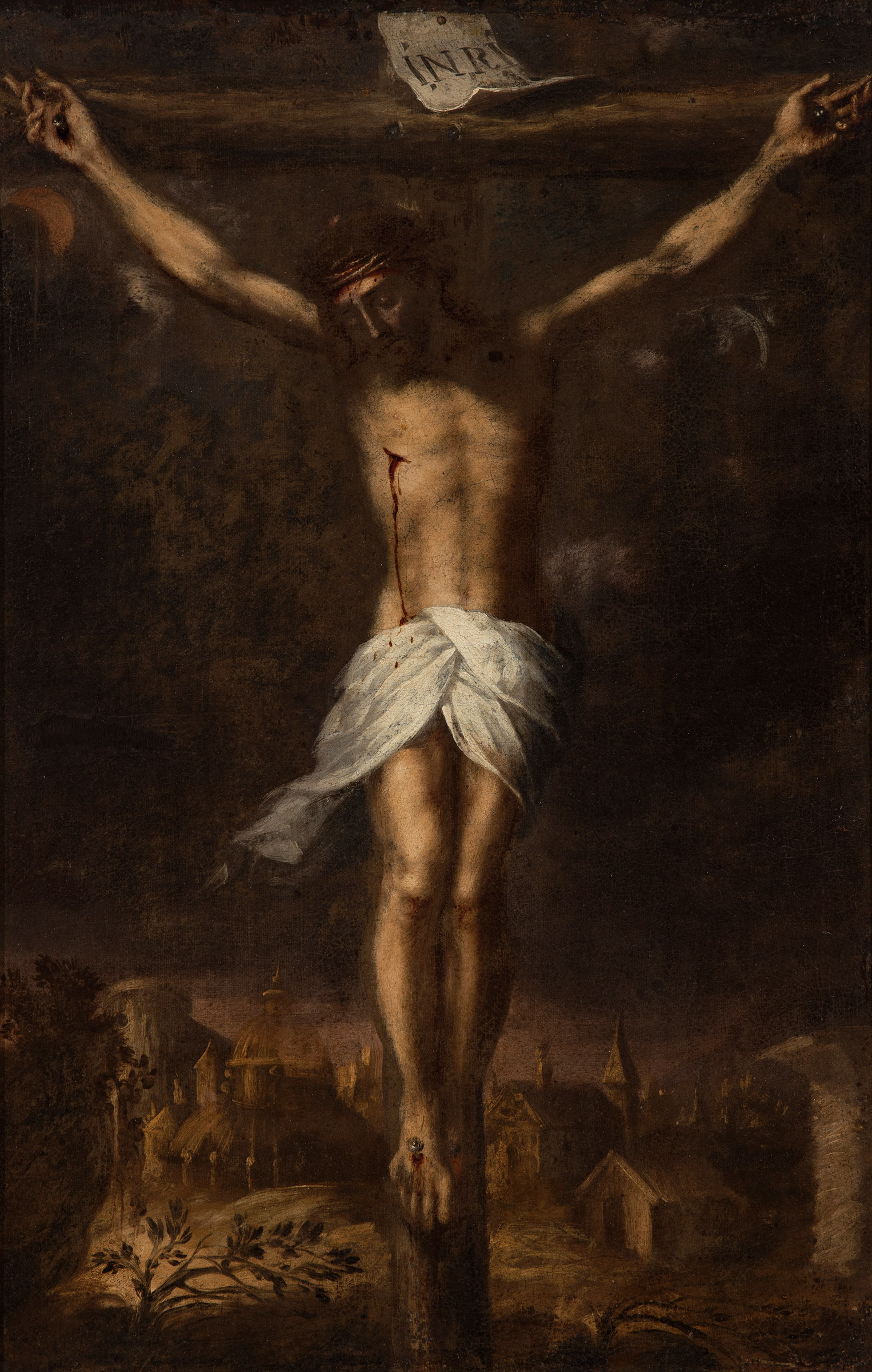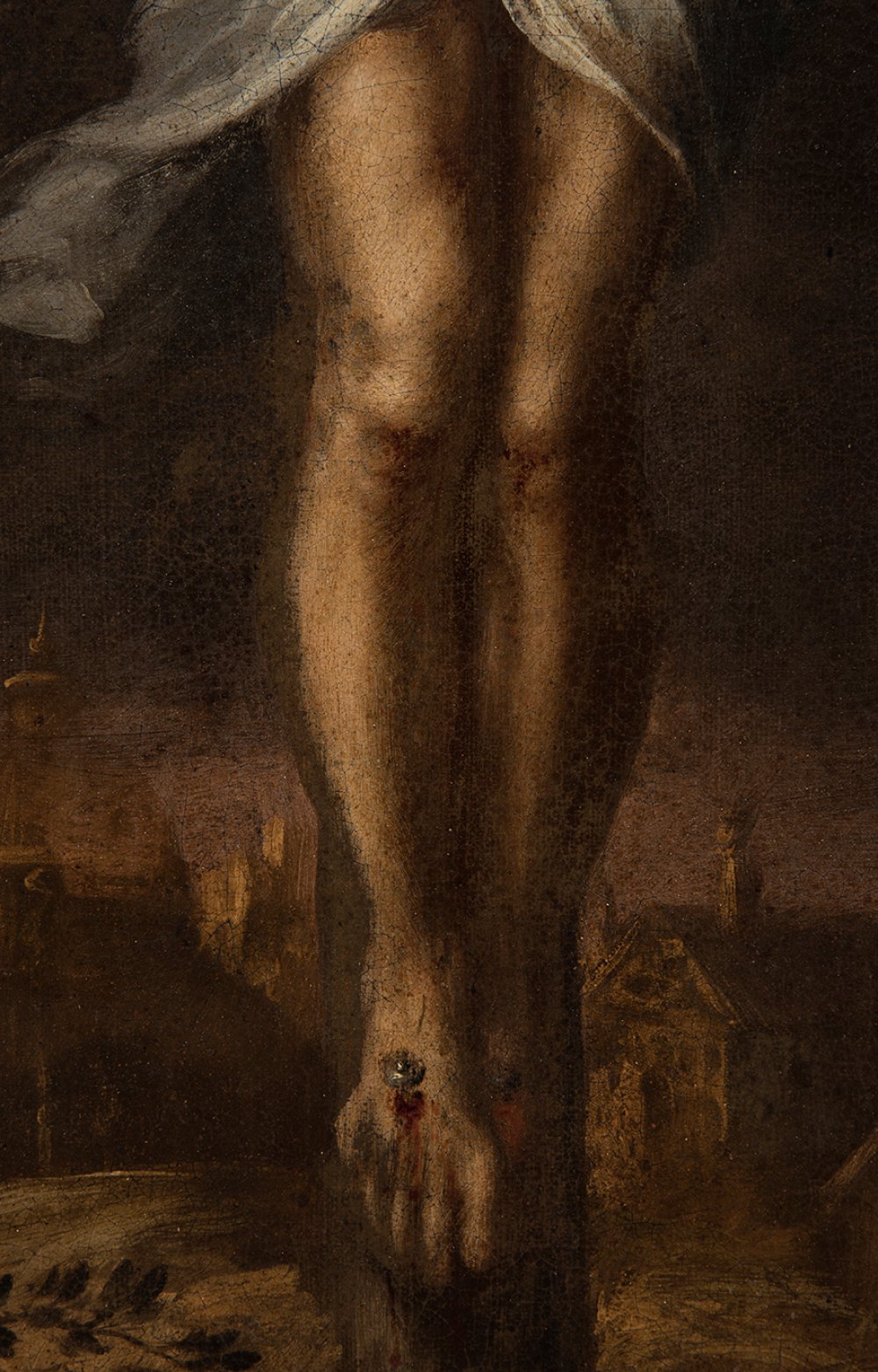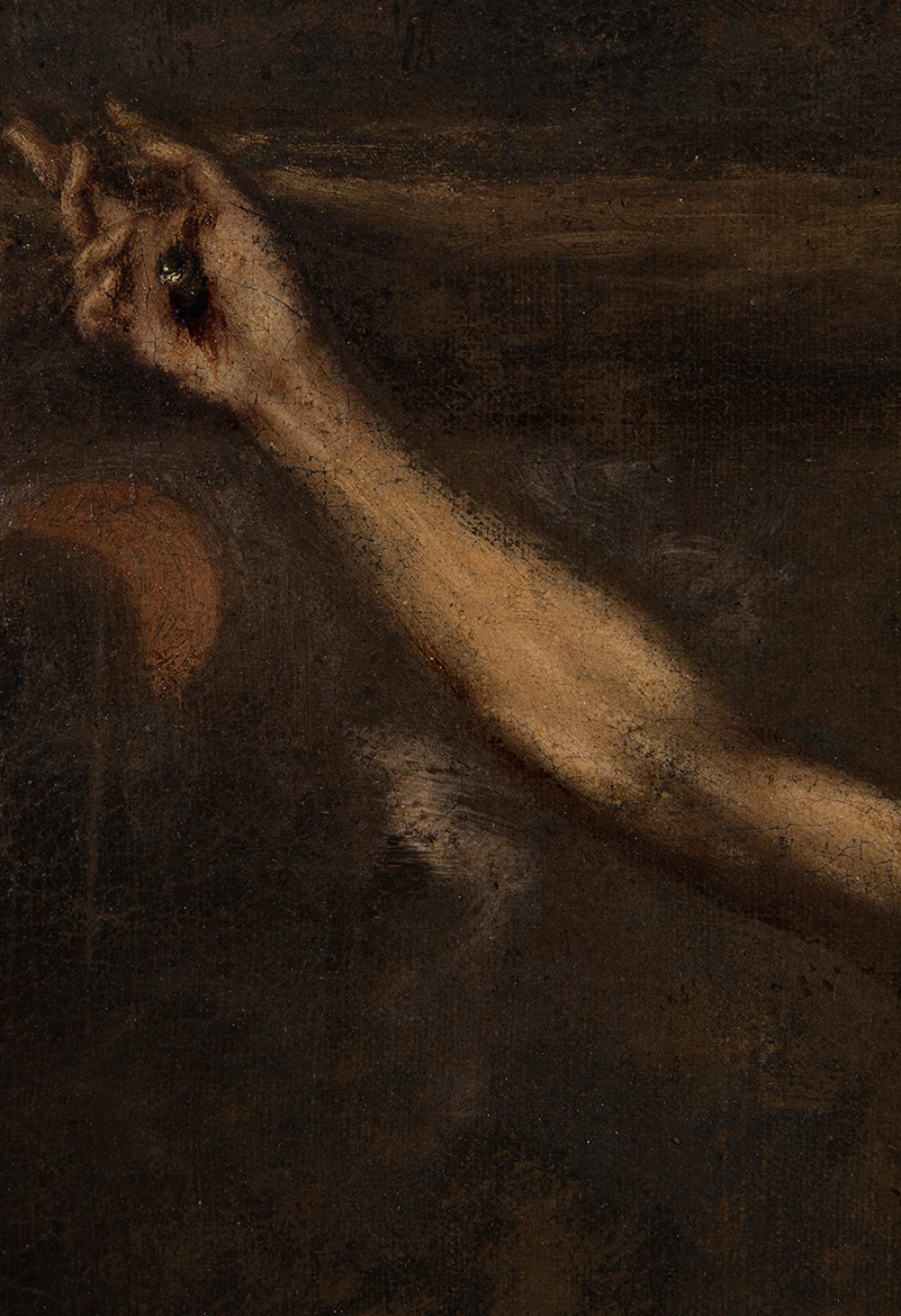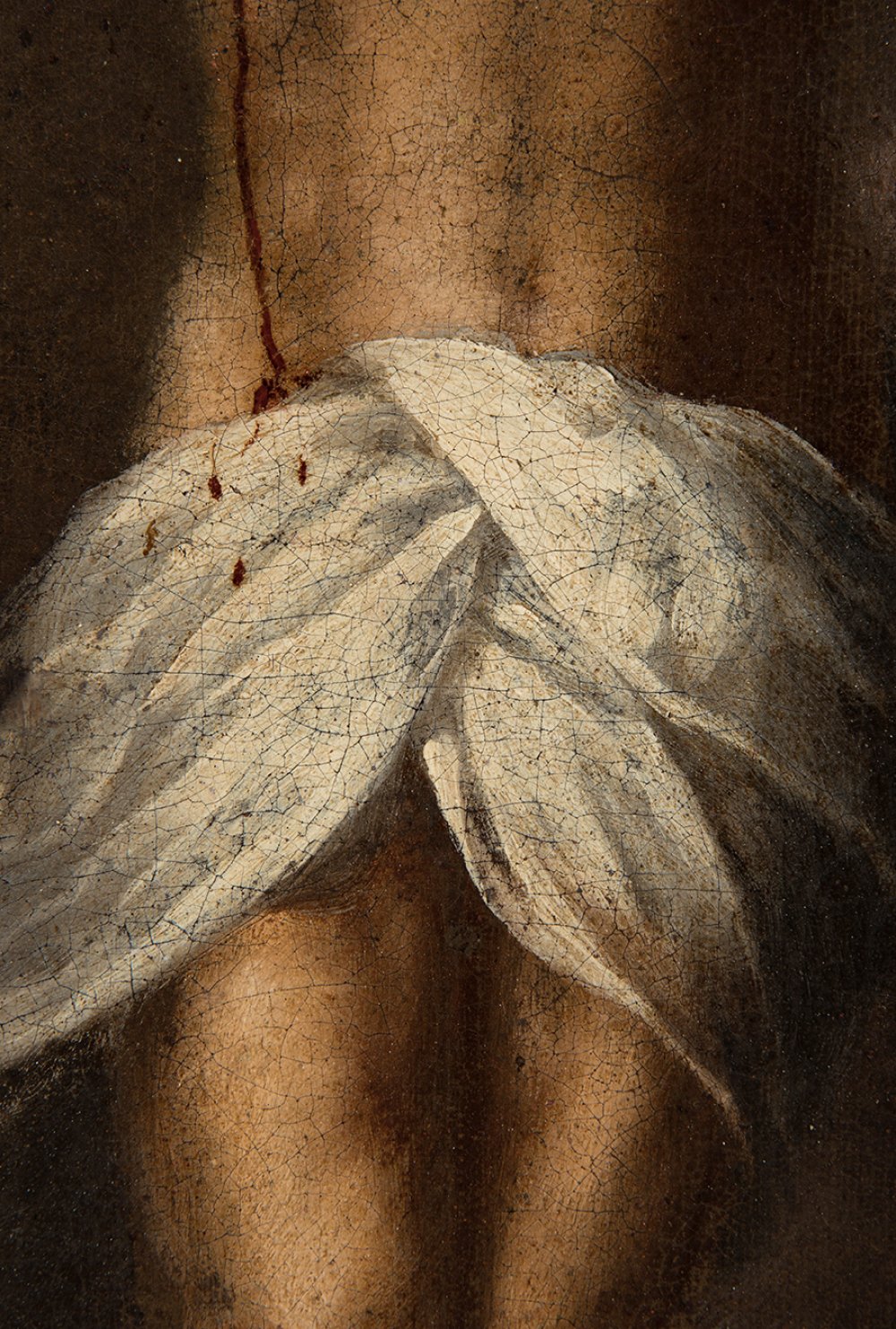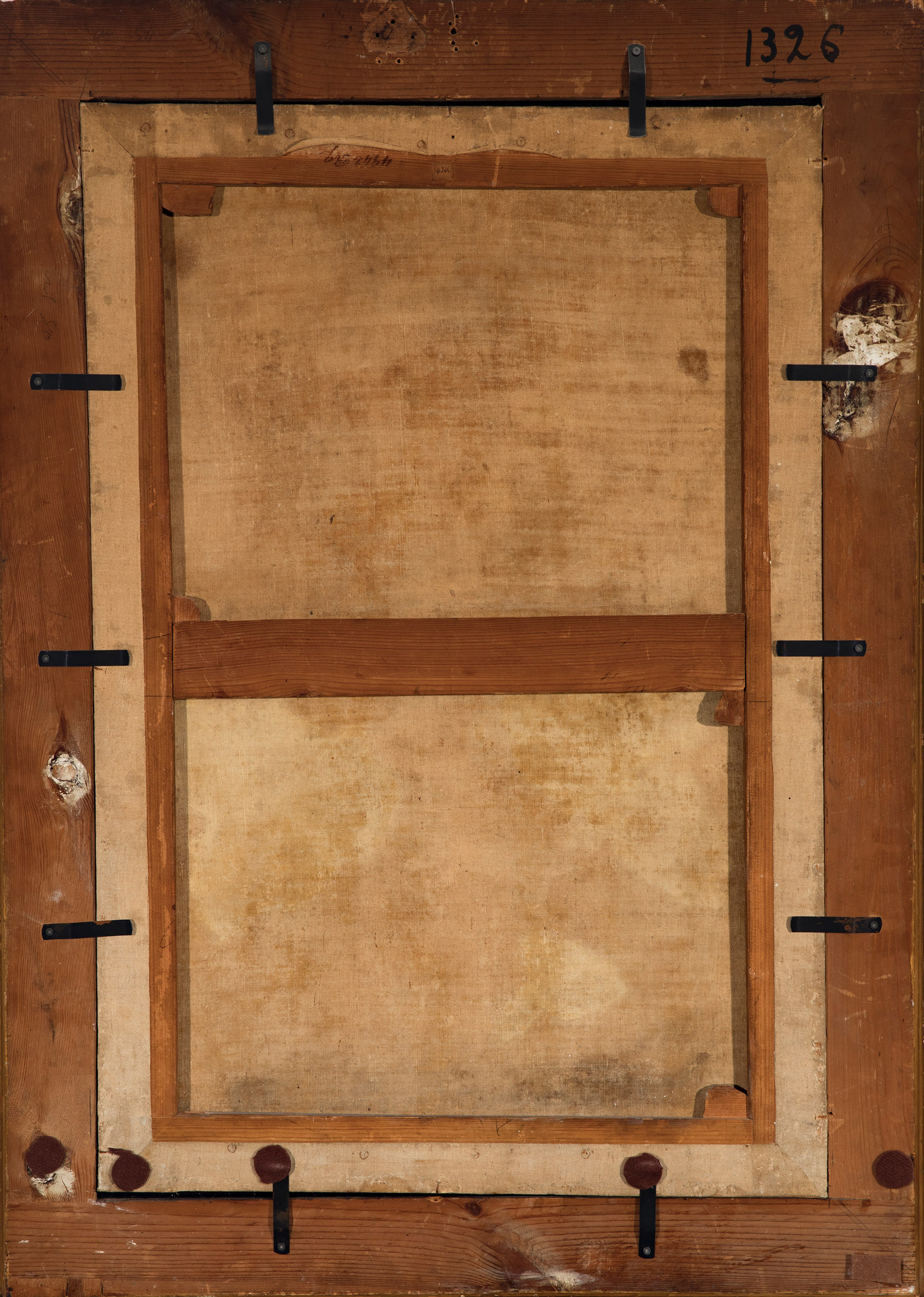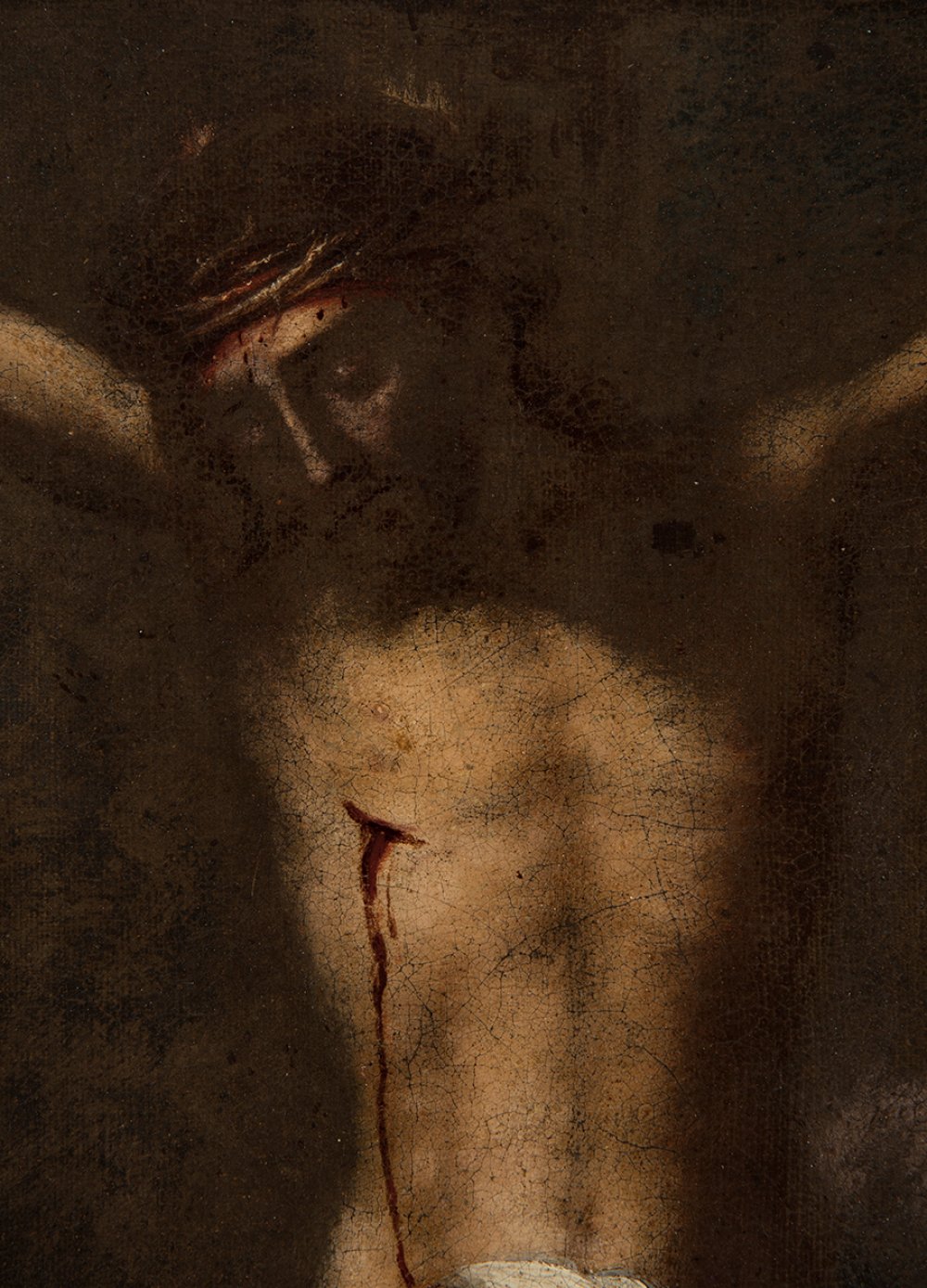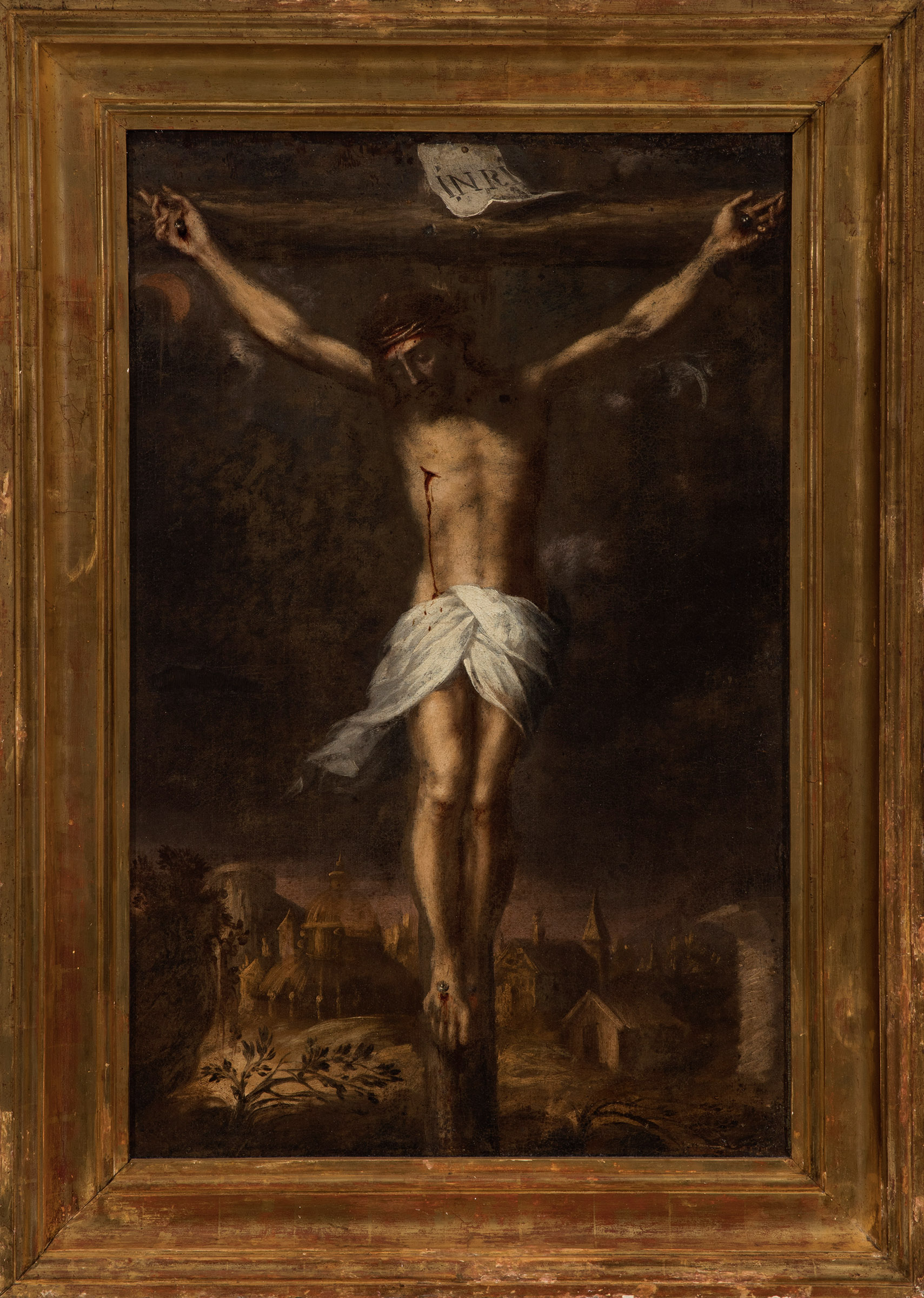12
Circle of BARTOLOME ESTEBÁN MURILLO (Seville, 1617 - 1682); 18th century."Christ crucified".Oil on
"Christ crucified".
Oil on canvas. Re-retouched.
It has repainting and restorations.
It has a gilded frame made from antique elements.
Measurements: 80 x 54 cm; 98 x 70 cm (frame).
This work follows the models established by the master Don Bartolomé Esteban Murillo in his work "The Crucifixion", painted in 1667 and which is currently part of the collection of the Prado Museum in Madrid, although numerous versions were made, such as the one in the MET in New York. The value that Murillo's painting attained was so great that Pacheco noted it in his writings, giving it greater importance than Titian. For this reason it is not surprising that copies of his works and followers proliferated. In this particular piece the artist rescues the Christ with three nails, without excess blood, but adds a setting populated by architectural constructions that break with the sobriety of the Murillo image.
Little is known of Murillo's childhood and youth, except that he lost his father in 1627 and his mother in 1628, which is why he was taken into the care of his brother-in-law. Around 1635 he must have begun his apprenticeship as a painter, most likely with Juan del Castillo, who was married to a cousin of his. This working and artistic relationship lasted about six years, as was customary at the time. After his marriage in 1645 he embarked on what was to be a brilliant career that gradually made him the most famous and sought-after painter in Seville. The only trip he is known to have made is documented in 1658, when Murillo was in Madrid for several months. It is conceivable that while at court he kept in touch with the painters who lived there, such as Velázquez, Zurbarán and Cano, and that he had access to the collection of paintings in the Royal Palace, a magnificent subject of study for all the artists who passed through the court. Despite the few documentary references to his mature years, we know that he enjoyed a comfortable life, which enabled him to maintain a high standard of living and have several apprentices. Having become the city's leading painter, surpassing even Zurbarán in fame, he was determined to raise the artistic level of local painting. In 1660 he decided, together with Francisco Herrera el Mozo, to found an academy of painting, of which he was the main driving force. His fame spread so far throughout Spain that Palomino states that around 1670 King Charles II offered him the possibility of moving to Madrid to work there as a court painter. We do not know whether this reference is true, but the fact is that Murillo remained in Seville until the end of his life. His works are now in the most important art galleries in the world, such as the Prado Museum, the Hermitage in St. Petersburg, etc.
"Christ crucified".
Oil on canvas. Re-retouched.
It has repainting and restorations.
It has a gilded frame made from antique elements.
Measurements: 80 x 54 cm; 98 x 70 cm (frame).
This work follows the models established by the master Don Bartolomé Esteban Murillo in his work "The Crucifixion", painted in 1667 and which is currently part of the collection of the Prado Museum in Madrid, although numerous versions were made, such as the one in the MET in New York. The value that Murillo's painting attained was so great that Pacheco noted it in his writings, giving it greater importance than Titian. For this reason it is not surprising that copies of his works and followers proliferated. In this particular piece the artist rescues the Christ with three nails, without excess blood, but adds a setting populated by architectural constructions that break with the sobriety of the Murillo image.
Little is known of Murillo's childhood and youth, except that he lost his father in 1627 and his mother in 1628, which is why he was taken into the care of his brother-in-law. Around 1635 he must have begun his apprenticeship as a painter, most likely with Juan del Castillo, who was married to a cousin of his. This working and artistic relationship lasted about six years, as was customary at the time. After his marriage in 1645 he embarked on what was to be a brilliant career that gradually made him the most famous and sought-after painter in Seville. The only trip he is known to have made is documented in 1658, when Murillo was in Madrid for several months. It is conceivable that while at court he kept in touch with the painters who lived there, such as Velázquez, Zurbarán and Cano, and that he had access to the collection of paintings in the Royal Palace, a magnificent subject of study for all the artists who passed through the court. Despite the few documentary references to his mature years, we know that he enjoyed a comfortable life, which enabled him to maintain a high standard of living and have several apprentices. Having become the city's leading painter, surpassing even Zurbarán in fame, he was determined to raise the artistic level of local painting. In 1660 he decided, together with Francisco Herrera el Mozo, to found an academy of painting, of which he was the main driving force. His fame spread so far throughout Spain that Palomino states that around 1670 King Charles II offered him the possibility of moving to Madrid to work there as a court painter. We do not know whether this reference is true, but the fact is that Murillo remained in Seville until the end of his life. His works are now in the most important art galleries in the world, such as the Prado Museum, the Hermitage in St. Petersburg, etc.
28th September - Old Masters
Sale Date(s)
Venue Address
General delivery information available from the auctioneer
Setdart offers Worldwide shipping
PICK UP IN ROOM: You can come and pick up your lots in our offices (Barcelona, Madrid or Valencia). At the moment of the withdrawal, you will be able to accept the current conditions of the lot by means of a document that you will sign.
YOU CAN SEND ANOTHER PERSON TO PICK UP: This person must present a signed authorization that you can find in our web page by accessing from BUY AT SETDART- LOGISTICS-DOWNLOAD AUTHORIZATION DOCUMENT. You can also send an e-mail with the requested data in AUTHORIZATION DOCUMENT to admin@setdart.com
Important Information
25% buyer´s premium
21% buyer´s premium at www.setdart.com
Terms & Conditions
The maximum period to pay the lots is 7 working days. You can pay either via bank transfer or with credit card through our platform www.setdart.com (we only accept VISA or Mastercard).
BUYER´S PREMIUM: 22% Hammer price + 21% VAT from the buyer´s premium
If your piece has more than 100 years, our Ministry of Culture requires an export certificate in order for the piece to leave the country. Note that if the piece goes inside the EU, there is no cost for the export certificate. If the piece goes outside the EU, there is a cost for the export certificate. You can find more information in our Ministry of Culture website: https://www.culturaydeporte.gob.es/en/cultura/patrimonio/exportacionimportacion/exportacion/tasas.html
INQUIRIES: admin@setdart.com
Setdart guides you through the entire process, from the time of award to the day you receive your lot. Our logistics team will be happy to manage your transport, and will advise you on the best shipping method with professionals from the sector used to handling works of art and jewelry.
WE OFFER WORLDWIDE DOOR TO DOOR SHIPPING
PICK UP IN ROOM: You can come and pick up your lots in our offices. At the moment of the withdrawal, you will be able to accept the current conditions of the lot by means of a document that you will sign.
YOU CAN SEND ANOTHER PERSON TO PICK UP: This person must present a signed authorization that you can find in our web page by accessing from BUY AT SETDART-LOGISTICS-DOWNLOAD AUTHORIZATION DOCUMENT. You can also send an e-mail with the requested data in AUTHORIZATION DOCUMENT to admin@setdart.com
SETDART IS NOT RESPONSIBLE FOR THE STATE OF THE PARTS ONCE THEY LEAVE OUR FACILITIES. MRW SHIPMENTS: Once the payment is made, your lot will be packed for shipment, the logistics department will send you an e-mail notifying you of the day it leaves our warehouse, changes of address cannot be made after receiving this e-mail.
INSURANCE INCIDENTS: Coverage for the value of the auction up to 3000 ? per shipment, if the value of the auction is higher, Setdart will send you a quote including the additional insurance. The insurance company WILL NOT BE RESPONSIBLE FOR THE SHIPMENT THAT EXCEEDS THAT AMOUNT AND IS NOT FULLY INSURED. MRW INCIDENTS: Maximum notification 48 hours after receipt, after which the insurance company WILL NOT BE RESPONSIBLE AND NO CLAIMS WILL BE ACCEPTED.
E-MAIL LOGISTICS: logistica@setdart.com
PICK UP YOUR MESSAGES: You can send your own messaging, prior notice via e-mail that your shipment is ready, please note 3 or 4 days in advance. This type of shipment is packaged so Setdart will provide you with a quote.
EXPENSES FOR STORAGE: We inform you that if the purchased lot is not picked up within a month, you will be charged 30€ per week per lot. Setdart Online S.L., owner of the web site "setdart.com", "setdart.net" and "setdart.org", acts as a company of Spanish nationality inscribed in the Volume 36955, sheet 182, page B-293056 of the Mercantile Registry, with registered office at Calle Aragó















